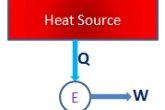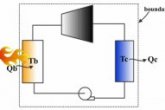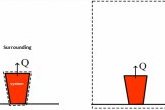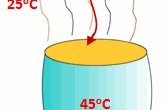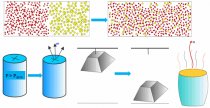 Second law of thermodynamics is law of nature, unarguably one of the most valuable find of mankind. But this topic is somewhat confusing for most of the students and engineers. This video is aimed at describing 2nd law in an engineer's point of view.
Second law of thermodynamics is law of nature, unarguably one of the most valuable find of mankind. But this topic is somewhat confusing for most of the students and engineers. This video is aimed at describing 2nd law in an engineer's point of view.
Uses of Second Law
We will start our discussion by going through uses of 2nd law. They are listed below.
-
Direction of a Process
- Most important use of second law is to determine direction of a process. First law of thermodynamics tells the user only about energy transfer, it does not specify in which direction energy transfer will happen for a given condition. Consider following examples.According to first law hot tea can gain heat, mass can go up and mixed gas can become unmixed spontaneously. It is 2nd law of thermodynamics which comes in between and tells in which direction a process is possible spontaneously.
Well, you could argue that you can find out direction of all this processes without using second law (from your intuition). Then what about following process, a chemical reaction.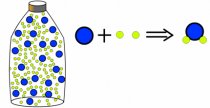
Fig.1 Second law is used to determine in which direction above processes will happen spontaneously Fig.2 Second law can even check whether the chemical reaction above is spontaneous or not
Can you say in which direction reaction will go spontaneously from your intuition ? Using 2nd law you can predict even this, you can predict whether the blue atoms and yellow atoms combine together to form a new molecule spontaneously. -
Maximum Possible Thermal Efficiency
-
Another main use of 2nd law is in determining maximum possible thermal efficiency of a given system. 2nd law of thermodynamics puts a limit for maximum performance a system can achieve. For example you can find whats the maximum thermal efficiency possible for a car engine or refrigerator just by knowing its heat interaction temperatures.
Classical Statements of 2nd Law
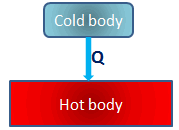 2nd law has got 2 classical statements, they are self-similar.
2nd law has got 2 classical statements, they are self-similar.
-
Clausius Statement
- According Clausius statement heat cannot flow from a hot body to cold body without any external work.This is depicted in following figure.
Fig.3 Clausius statement does not permit the process shown here
-
Kelvin-Planck Statement
Accoriding to Kelvin-Planck statement a heat engine cannot produce work without rejecting some heat to the surrounding. This is depicted in following figure.
Fig.4 Kelvin-Planck statement does not premit the process shown in figure
Clausius Inequality - 2nd Law in a Useful form for Engineers
Clausius and Kelvin-Planck are 2 classical statements of 2nd law, but they are not in a form which is directly useful for engineers.Most useful form of 2nd law is Clausius inequality, It states that cyclic integral of dQ/T along boundary of a cycle will always be less than or equal to zero.
Here temperature T should be in Kelvin.Right hand side of this equation becomes zero when there is no irreversibility present in the cycle, irreversibilities like friction or vertices. Consider following example, a power production cycle.Fig.5 Clausius inequality applied on a power plant cycle, dotted line represents boundary of the cycle
Here there are 2 heat interactions in the cycle, one at condenser represented by 'c' next is at boiler represented by 'b'. Assuming there are no irreversibilities present and heat interactions are in uniform temperature, then Clausius inequality reduces to
